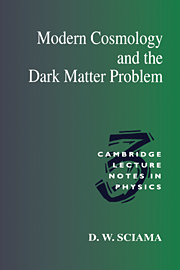Book contents
- Frontmatter
- Contents
- Preface
- Recent Developments
- Part One Dark Matter in Astronomy and Cosmology
- Part Two Ionisation Problems in Astronomy and Cosmology
- Part Three Neutrino Decay and Ionisation in the Universe
- 8 The Radiative Decay of Massive Neutrinos
- 9 Neutrino Decay and the Ionisation of the Milky Way
- 10 Neutrino Decay and the Ionisation of Spiral Galaxies
- 11 The Intergalactic Flux of Ionising Decay Photons
- 12 The Reionisation of the Universe
- Part Four Observational Searches for the Neutrino Decay Line
- References
- Subject index
9 - Neutrino Decay and the Ionisation of the Milky Way
Published online by Cambridge University Press: 11 January 2010
- Frontmatter
- Contents
- Preface
- Recent Developments
- Part One Dark Matter in Astronomy and Cosmology
- Part Two Ionisation Problems in Astronomy and Cosmology
- Part Three Neutrino Decay and Ionisation in the Universe
- 8 The Radiative Decay of Massive Neutrinos
- 9 Neutrino Decay and the Ionisation of the Milky Way
- 10 Neutrino Decay and the Ionisation of Spiral Galaxies
- 11 The Intergalactic Flux of Ionising Decay Photons
- 12 The Reionisation of the Universe
- Part Four Observational Searches for the Neutrino Decay Line
- References
- Subject index
Summary
Introduction
In this chapter we introduce the basic idea of our neutrino decay theory. According to this idea (Sciama 1990a) the widespread ionization of the Milky Way is mainly due to photons emitted by dark matter neutrinos pervading the Galaxy. This idea was proposed because it would immediately solve all the problems described in chapter 5, which arise from the conventional hypothesis that the ionisation sources are bright stars or supernovae. In particular, the ubiquity of the neutrinos could compensate for the small mean free path (≲ 1 pc) of the ionising photons in the intercloud medium, and their halo distribution could account for the large scale height (∼ 670 pc) of the ionised gas in the Reynolds layer.
Of course we can exploit these structural features of the basic idea only if the neutrino decay lifetime τ that would be required is otherwise reasonable. We shall find that we need τ ∼ 2 to 3 × 1023 sees. This value is (just) compatible with the lower limits derived in chapter 8, and with certain particle physics theories which are described there. Adopting this lifetime would also have major implications for a large variety of phenomena in astronomy and cosmology other than the ionisation of the Galaxy, and would enable several puzzling problems to be solved.
The most remarkable consequence of the resulting theory is that its domain of validity is highly constrained. As we shall see, it can be correct only if the decay photon energy Eγ, the rest mass mv of the decaying neutrinos, and the Hubble constant H0 each has a value specified with a precision τ 1 per cent.
- Type
- Chapter
- Information
- Modern Cosmology and the Dark Matter Problem , pp. 128 - 147Publisher: Cambridge University PressPrint publication year: 1994



